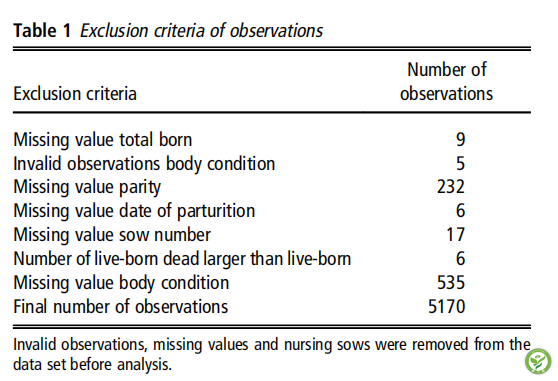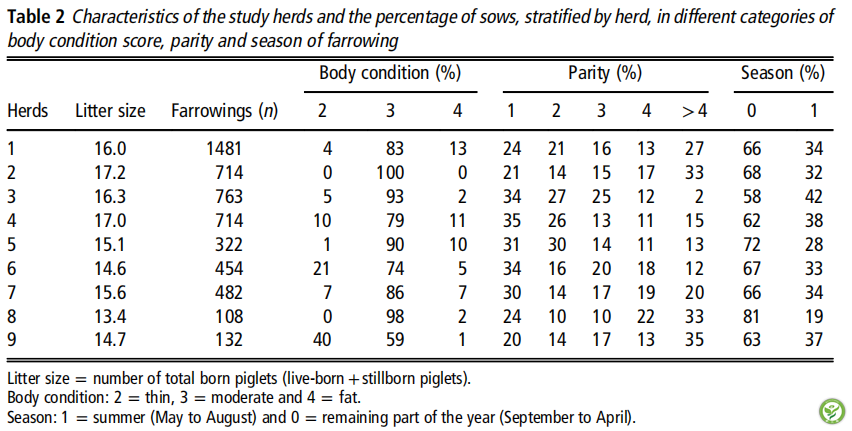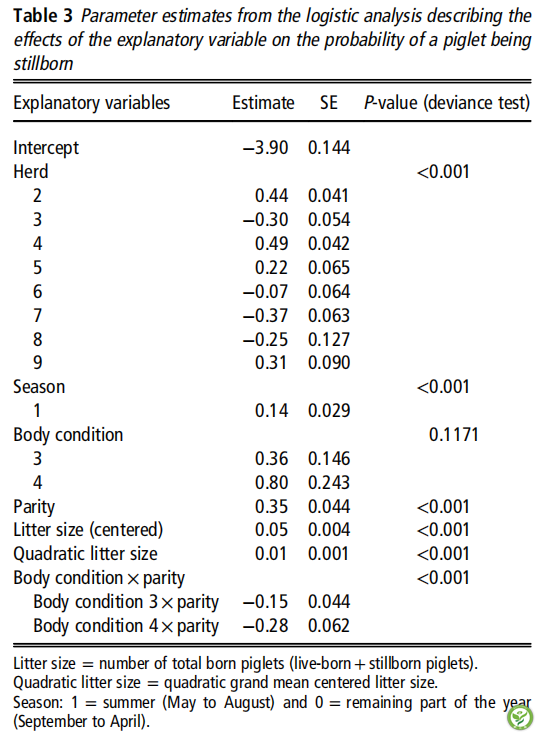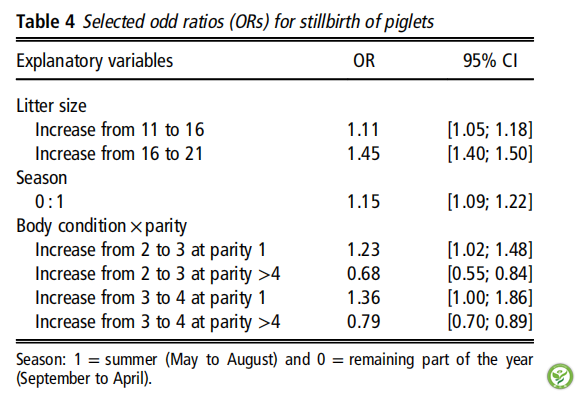丹麦有机母猪群中引起仔猪死胎的母猪方面的风险因素
Sow-level risk factors for stillbirth of piglets in organic sow herds
作者:L. Rangstrup-Christensen†, M. A. Krogh, L. J. Pedersen and J. T. Sørensen
Department of Animal Science, Aarhus University, DK-8830 Tjele, Denmark
来源:Animal (2017), 11:6, pp 1078-1083 doi:10.1017/S1751731116002408
翻译:肠动力研究院 梁琦
【摘要】在丹麦有机猪的生产过程中,约三分之一的新生仔猪在断奶前死亡,据统计,死胎占断奶前总死亡率的27%。本文旨在评估季节、窝产仔数、胎次和母猪的体况等风险因素对丹麦9个商业化有机猪群中仔猪死胎率的影响。该研究历时1年,数据包括5170份分娩记录,共有82906头初生仔猪参与评估。结果显示,母猪群的平均窝产仔数为16.0头,其中平均死胎数为1.1头。与全年其他时间(9月-来年4月)相比,夏季(5月-8月)仔猪的死胎为1.15,有显著的季节效应。同时,当产仔数由11增加到16时,死产比为1.11,由此可见产仔数的非线性效应。产仔数由16增加至21时,死产比为1.45。除此外,母猪体况与胎次之间存在显著的交互作用。在1胎母猪中,母猪体况得分(BCS)从2(瘦)增加到3(适中),从3增加到4(胖)均会增加死产概率,比值分别为1.23和1.36。而在胎次>4的母猪中,BCS从2增加到3和从3增加到4则会降低死产概率,比值分别为0.68和0.79。总之,产仔数的增加和在夏季(5月-8月)出生是仔猪死产的危险因素。此外,体况和胎次之间的交互作用表明,与正常和肥胖母猪(胎次>4)相比,瘦弱母猪(胎次>4)的死产风险显著增加。相比之下,对于1胎母猪而言,肥胖母猪的死产风险将增加。
【关键词】死胎 有机猪生产 体况 胎次 窝产仔数
以下为相关图表
表1:观察的排除标准

表2:研究群的特征和母猪的比例,按群分,体况得分,胎次和分娩季节的不同类别

表3:从描述解释变量对仔猪死产概率的影响中进行逻辑分析中得到的参数评估

表4:挑选的部分仔猪死产比率(OR)

图1:按胎次对每种体况评分(BCS)中死产仔猪的比例进行分类,与肥胖的1胎母猪相比,瘦弱的1胎母猪死产仔猪的比例较低。相反,与胎次>4的瘦弱母猪相比,胎次>4的肥胖母猪死产仔猪的比例更低。BCS中2 =瘦,3 =中,4 =胖。百分比是使用logistic分析的参数估计值计算的(表3)。

结论
该研究表明,夏季(5月-8月)出生和产仔数超过17头仔猪是丹麦9个有机猪群死产的危险因素。体况和胎次之间的交互作用表明,与正常和肥胖母猪(胎次>4)相比,瘦弱母猪(胎次>4)的死产风险显著增加。相比之下,与瘦弱的1胎母猪相比,肥胖的1胎母猪的死产风险会增加。
Abstract
In Danish organic pig production, one-third of total born piglets die before weaning, and stillbirth has previously crudely been estimated to account for 27% of the total preweaning mortality. The objective of this study was to evaluate season, litter size, parity and body condition of the sow as risk factors for stillbirth in nine commercial Danish organic pig herds. The study was conducted over a 1-year period, and the data included registrations on 5170 farrowings with 82 906 total born piglets. The average number of total born piglets per litter was 16.0, and the number of stillborn piglets per litter was 1.1. A significant effect of season was seen with an odds ratio for stillbirth of 1.15 during summer (May to August) compared with the remaining part of the year. A non-linear effect of litter size was seen where an increase in litter size from 11 to 16 resulted in an odds ratio of stillbirth of 1.11. An increase in litter size from 16 to 21 resulted in an odds ratio of stillbirth of 1.45. A significant interaction between body condition and parity was present. In first parity sows, an increase in body condition score from 2 (thin) to 3 (moderate) and from 3 to 4 (fat) increased the probability of stillbirth with an odds ratio of 1.23 and 1.36, respectively. In sows with parity above 4, an increase in body condition score from 2 to 3 and from 3 to 4 decreases the probability of stillbirth with an odds ratio of 0.68 and 0.79, respectively. In conclusion, increasing litter size and being born during the summer months of May to August were found to be risk factors for stillbirth. Furthermore, an interaction between body condition and parity showed that thin sows with parity above 4 had a substantially increased risk of stillbirth compared with normal and fat sows with parity above 4. In contrast, for parity 1 sows risk of stillbirth was increased in fat sows.
Keywords: stillbirth, organic pig production, body condition, parity, litter size
Conclution
The study showed that being born during the summer months (May to August) and a litter size of more than 17 piglets are risk factors for stillbirth in nine organic pig herds in Denmark. An interaction between body condition and parity was present showing that thin sows with parity above 4 had a substantially increased risk of stillbirth compared with normal and fat sows with parity above 4. In contrast, for parity 1 sows risk of stillbirth was increased in fat sows compared with thin parity 1 sows.
如您需原文,请联系本文作者和出版方,或请垂询肠动力研究院。本网站发布的所有资料将尽最大可能注明出处、作者及日期,如无意中侵犯了您的知识产权,请来信及时告知,我们将立即予以删除。
All information released by the WeChat Official Account will do its best to indicate the source, author and date. If we inadvertently infringe on your intellectual property, please inform us in time and we will delete it immediately.




